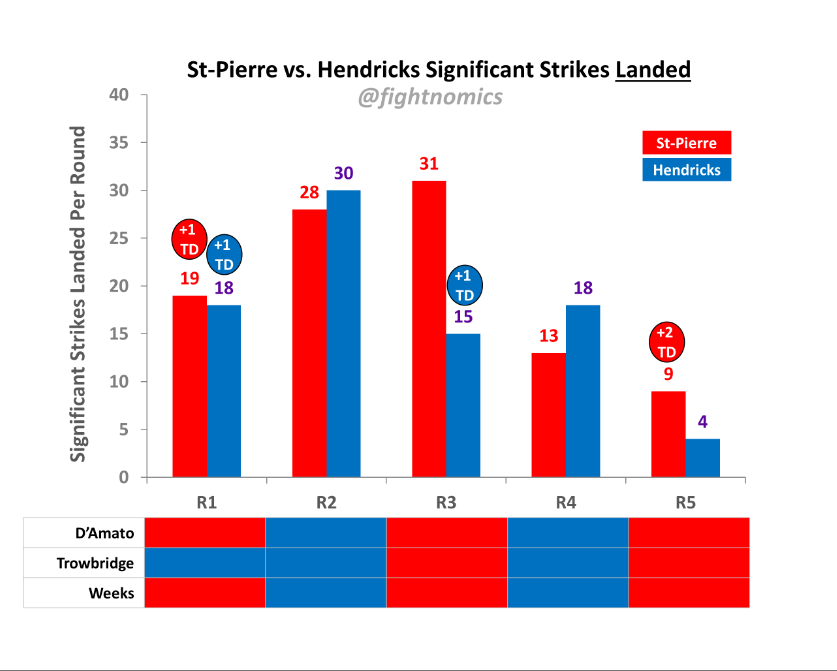By Reed Kuhn, @Fightnomics, Fightnomics.com Another title fight decision, and another controversy regarding the judges’ scorecards. In prior analysis I found that the close fight between Jon Jones and Alexander Gustafsson revealed somewhat inconsistent judging scores. So today I was eager to see how the UFC 167 championship fight between Georges St-Pierre and Johny Hendricks looked on paper, and where the disagreement was on the cards that resulting in a split decision over the winner. The chart below shows Significant Strikes Landed by round, and aligns the scoring of each of the three judges to each round.
There was actually only one round where a single judge disagreed with the others: Trowbridge scored round one for Hendricks, while D’Amato and Weeks gave St-Pierre the round. The rest of the fight the judges were consistent in their scores, alternating winners over the remaining four rounds. St-Pierre took rounds three and five on all three cards, while Hendricks was a unanimous winner in rounds two and four. According to the chart, these scores make sense. In the unanimously scored rounds the fighter who won was indeed the more successful striker. Had I graphed “attempts” rather than landed strikes, the chart would look the same, with the more active fighter winning the exact same rounds. The disagreement in round one corresponds to the closest round of all. Was it a coin flip that just happened to cause the judges to give the benefit of the doubt to the champion? Each fighter landed one takedown, and almost exactly the same number of significant strikes. But what else happened? According to FightMetric, St-Pierre attempted 36 significant strikes, and 48 total strikes (strikes that aren’t “significant” are jabs in the clinch or on the ground) in round one. Meanwhile, Hendricks attempted 26 significant strikes and 37 in total. St-Pierre also had one unsuccessful submission attempt. So St-Pierre was the more active fighter in the round despite having lower overall accuracy. And there’s the trick. Judges can’t count every strike that lands, and they don’t have any access to statistics during the course of a fight. So what they’re left with is an impression of who was more active, which likely led to the award of round one to St-Pierre for two out of three judges. On the other hand, for Trowbridge to have given the round to Hendricks, it must mean that the effectiveness of his striking trumps the volume from St-Pierre. Who is right? Judging isn’t an exact science; they are, after all, only human. Imperfections are guaranteed. But looking back at hard numbers and aligning them to how judges scored each round is, in my opinion, a valuable exercise. It allows us to isolate where disagreement occurred, and hopefully spark a conversation of how and why judges render the decisions they do. Hopefully this helps inform future scoring rules and judge training, and puts judges on the spot to explain why they disagreed over a certain round so that we can understand why their opinions differ. Maybe commissions can even endeavor to agree on which way is the “right” way to score a round in the future. But I would assume a big-time athletic commission does this kind of thing themselves, right?
